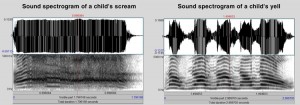
No one likes to hear a child cry, but one researcher at the University of Connecticut is listening intently.
Professor James A. Green, head of the Department of Psychology in the College of Liberal Arts and Sciences, is analyzing acoustic and video recordings of infant and toddler temper tantrums in order to document the wide range of human emotions that are expressed when a child seems out of control.
Green hopes the recordings will help researchers better understand the different emotional stages that a child goes through during a tantrum and provide insight into how parent-child dynamics impact a toddler’s emotional development. While tantrums are normative for toddlers between the ages of 18 months and 4 years, high rates of tantrums and tantrums that continue into later ages have been associated with future antisocial behavior and psychopathology.
In his most recent research, which was published in the scientific journal Emotion in October, Green collected recordings of toddlers screaming, yelling, crying, and whining during tantrums in order to study how small children express and regulate strong emotions and to see whether certain parental interactions are more effective than others at curtailing outbursts.
In the study, Green teamed up with University of Minnesota professor Michael Potegal, a pediatric neuroscientist who served as the co-principal investigator, and Pamela Whitney, a UConn graduate student, in order to categorize 2,400 different sounds from 20 different tantrums. Potegal brought a portable studio with both audio and visual recording equipment to the homes of the 13 toddlers who participated in the study. The parents dressed their children in outfits equipped with microphones and would record their 2- to 3-year-olds playing with them for extended periods. If the child had a tantrum, the parents were instructed to turn off the recording devices once the tantrum was over and to contact a researcher. Afterward, the parents also filled out a questionnaire eliciting further details about their interactions with their child during the tantrum.
“People are very interested in temper tantrums, especially parents,” Green says.
Green is already seeing some potentially interesting results when it comes to parents’ attempts at stopping an outburst.
“We have some preliminary data suggesting that in the midst of a tantrum, it may be more effective for parents to issue short and simple declarative statements, such as “It’s time to get in the car,” than to ask questions of the toddler such as “Would you like to get in the car?” says Green. “But the data are preliminary and our work is ongoing.”

Green says the recordings show that most tantrums begin with screaming and yelling, which are indicative of high anger, but eventually turn into whining and crying, which show comfort-seeking on the part of the toddler. Tantrums may exist as a method of independence-seeking for toddlers, he says, as they lack the cognitive skills and language to communicate this desire otherwise.
Once toddlers acquire these skills, he says, tantrums should begin to diminish.
Green believes his study is the first of its kind involving naturalistic recordings of temper tantrums.
There is very little literature on vocalizations as expressions of pre-linguistic emotions, he says, whereas there is a plethora of published materials on facial expressions.
Green, who says his work was partly inspired by Charles Darwin’s extensive documentation of facial expressions, says that both expressions and sounds can be recognized across nearly all cultures as representing distinct emotions.
“Most kids in most cultures have tantrums at some point in development,” he says. “They’re making faces during those tantrums, but they’re making sounds as well.”



